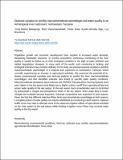| dc.description.abstract | Population growth and economic development have resulted in increased water demands, threatening freshwater resources. In riverine ecosystems, continuous monitoring of the river quality is needed to follow up on their ecological condition in the light of water pollution and habitat degradation. However, in many parts of the world, such monitoring is lacking, and ecological indicators have not been defined. In this study, we assessed seasonal variation in benthic macroinvertebrate assemblages in a tropical river catchment in northeastern Tanzania, which currently experiencing an increase in agricultural activities. We examined the potential of in-stream environmental variables and land-use patterns to predict the river macroinvertebrate assemblages, and also identified indicator taxa linked to specific water quality conditions. Macroinvertebrate abundance, taxon richness and TARISS (Tanzania River Scoring System) score were higher in the dry season most likely due to higher surface runoff from agricultural land and poorer water quality in the wet season. In the wet season macro invertebrates seem to be limited by chlorophyll-a, oxygen and phosphorous while in the dry season, when water flow is lower, nitrogen and turbidity become important. Substrate composition was important in both seasons. Given the fact that different selective filters limit macroinvertebrate assemblages in both seasons, a complete picture of water quality can only be established by monitoring in both seasons. Riparian buffer zones may help to alleviate some of the observed negative effects of agricultural activities on the river system in the wet season while limiting irrigation return flows may increase water quality in the dry season. | en_US |

